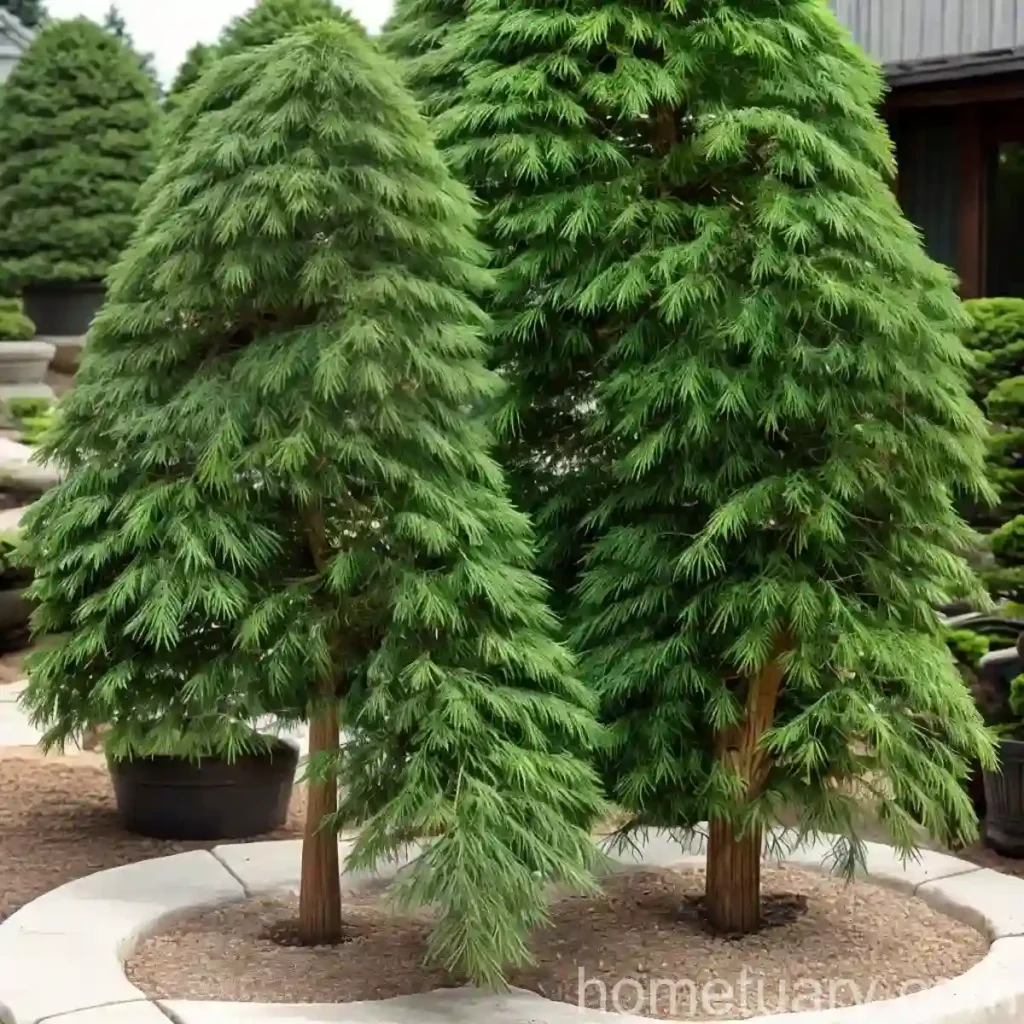The Wonderful World of Japanese Falsecypress (Chamaecyparis pisifera ‘Sungold’)
As a plant scientist with a passion for exploring the remarkable diversity of the plant kingdom, I am delighted to introduce you to the captivating Japanese falsecypress (Chamaecyparis pisifera ‘Sungold’). This stunning evergreen tree, with its striking golden foliage, has captured the hearts of gardeners and landscapers around the world. In this comprehensive guide, we will delve into the captivating world of Japanese falsecypress, exploring its cultural significance, practical uses, and essential care tips. Whether you are a seasoned horticulturist or an avid nature enthusiast, there is much to discover and appreciate about this magnificent plant.
What is Japanese Falsecypress (Chamaecyparis pisifera ‘Sungold’)?
Japanese falsecypress, scientifically known as Chamaecyparis pisifera, is a species of conifer that hails from Japan. ‘Sungold’ is a cultivar of Chamaecyparis pisifera, celebrated for its vibrant golden foliage, which adds a touch of brilliance to any landscape or garden. This compact, slow-growing evergreen tree belongs to the family Cupressaceae and is cherished for its elegant, feathery foliage and graceful, conical shape.
Key Takeaways – Japanese Falsecypress (Chamaecyparis pisifera ‘Sungold’)
As we embark on our exploration of the Japanese falsecypress, let’s begin with a succinct summary of the key takeaways about this enchanting plant:
-
Cultural Significance: Japanese falsecypress holds cultural significance in Japan and is revered for its symbolic representation of longevity and resilience in traditional Japanese gardens.
-
Practical Uses: ‘Sungold’ falsecypress is a versatile plant, often utilized as a focal point in landscapes, as well as for hedging, screening, and creating elegant container displays.
-
Essential Care Tips: Proper watering, sunlight exposure, soil conditions, and pruning are crucial aspects of nurturing Japanese falsecypress. Understanding its water requirements, sunlight preferences, fertilizer needs, and soil preferences is essential for maintaining its health and vibrant appearance.
-
Popularity: ‘Sungold’ falsecypress has garnered widespread popularity among gardeners and landscaping enthusiasts due to its stunning visual appeal and low-maintenance nature.
-
Common Diseases and Pests: While generally resistant to many diseases and pests, Japanese falsecypress may be susceptible to certain issues that require careful monitoring and proactive management.
Now, let’s delve deeper into these key aspects of Japanese falsecypress, unraveling the secrets of its care and cultivation.
Culture
The cultural significance of Japanese falsecypress extends far beyond its horticultural attributes. In Japan, this revered tree is deeply intertwined with traditional garden design and holds symbolic value in Japanese folklore. In Japanese gardens, Chamaecyparis pisifera is often associated with longevity and endurance, as it is believed to possess the qualities of resilience and steadfastness.
Uses
Landscaping
Japanese falsecypress, particularly the ‘Sungold’ cultivar, is a prized ornamental tree in landscaping. Its vibrant, golden foliage provides a striking contrast to the surrounding greenery, making it a popular choice for creating visually captivating landscapes. Whether planted as a standalone specimen, used in group plantings, or incorporated into rock gardens, Japanese falsecypress lends an air of elegance and sophistication to any outdoor space.
Hedging and Screening
Due to its dense foliage and compact growth habit, Japanese falsecypress is an excellent choice for creating hedges and screens. The ‘Sungold’ cultivar, in particular, adds a splash of color to formal and informal hedges, offering privacy and beauty in equal measure.
Container Display
The graceful form and vibrant foliage of ‘Sungold’ falsecypress make it an ideal candidate for container gardening. Whether adorning a patio, balcony, or pathway, this versatile plant brings a touch of charm and sophistication to any outdoor setting.
Water
Proper watering is essential for the health and vitality of Japanese falsecypress. While it demonstrates good tolerance to drought once established, regular watering, especially during its initial establishment phase, is crucial to ensure optimal growth and vigor. When watering ‘Sungold’ falsecypress, it is important to strike a balance, avoiding both prolonged dryness and excessive moisture.
Sunlight
Japanese falsecypress thrives in full sun to partial shade. When cultivating the ‘Sungold’ cultivar, it is important to provide ample sunlight to enhance the vibrancy of its golden foliage. However, it can also tolerate partial shade, making it a versatile choice for various lighting conditions in the landscape.
Fertilizer
To support the healthy growth and color intensity of ‘Sungold’ falsecypress, it is advisable to fertilize it with a balanced, slow-release fertilizer in early spring. The application of a well-balanced fertilizer will provide the necessary nutrients for robust growth and vibrant foliage coloration.
Soil
When it comes to soil preferences, Japanese falsecypress exhibits a preference for well-draining, loamy soil. While it can adapt to different soil types, ensuring good drainage is essential for preventing waterlogged conditions that can compromise the health of the plant.
Pruning
Pruning is an essential aspect of maintaining the desired shape and size of Japanese falsecypress. For the ‘Sungold’ cultivar, light pruning may be necessary to maintain its compact, conical shape and to remove any dead or diseased foliage. It is best to conduct pruning during the dormant season to minimize stress on the tree.
Propagation
Japanese falsecypress can be propagated through several methods, including seed propagation, hardwood cuttings, and grafting. While the process may require patience and skill, propagation allows for the production of new plants and the preservation of specific cultivars, such as ‘Sungold’.
Container Popularity
The ‘Sungold’ falsecypress is a popular choice for container gardening, owing to its compact size, graceful form, and vibrant foliage. Whether grown in small to medium-sized containers, this cultivar adds a touch of elegance to patios, balconies, and other outdoor spaces.
Common Diseases
Japanese falsecypress, including the ‘Sungold’ cultivar, is generally resilient to many common diseases. However, it may be susceptible to certain issues, including:
-
Canker Diseases: Pathogens such as Cytospora can cause cankers on the branches, leading to dieback and decline in the affected areas.
-
Root Rot: Prolonged waterlogging can result in root rot, a fungal disease that affects the root system and can lead to wilting and decline of the plant.
-
Needle Blight: Some needle blight pathogens can cause browning and defoliation of the foliage, impacting the aesthetic appeal of the tree.
Vigilant monitoring and prompt intervention are essential for managing and preventing these issues, ensuring the continued vigor and beauty of Japanese falsecypress.
Disease Diagnosis
Diagnosing diseases in Japanese falsecypress, particularly the ‘Sungold’ cultivar, requires careful observation of symptoms and, in some cases, laboratory analysis to identify the specific pathogens responsible for the disease. Consultation with a plant pathologist or experienced horticulturist may be necessary to accurately diagnose and address any disease issues.
Common Pests
While Japanese falsecypress is generally resistant to many pests, it may occasionally encounter certain pests that can affect its health and appearance. Common pests that may pose a threat to ‘Sungold’ falsecypress include:
-
Spider Mites: These tiny pests can cause stippling and discoloration of the foliage, affecting the overall aesthetic appeal of the plant.
-
Bagworms: Caterpillars of bagworm moths can feed on the foliage of Japanese falsecypress, potentially leading to defoliation if left unchecked.
-
Scale Insects: Scale insects can attach themselves to the branches and foliage, sapping the plant’s vitality and causing yellowing or wilting of the affected parts.
Careful monitoring and the use of appropriate pest management strategies are essential for preventing and mitigating pest infestations in Japanese falsecypress.
Botanist’s Tips
To ensure the optimal growth and appearance of Japanese falsecypress, including the ‘Sungold’ cultivar, consider the following botanist’s tips:
-
Consistent Moisture: While Japanese falsecypress can tolerate some dryness, particularly once established, it is beneficial to maintain consistent, moderate moisture levels to support its growth and vitality.
-
Avoid Waterlogging: To prevent the risk of root rot and other moisture-related issues, ensure that the soil has adequate drainage to prevent waterlogging.
-
Pruning Best Practices: When pruning Japanese falsecypress, adhere to best practices by using clean, sharp tools and avoiding excessive or drastic pruning that may compromise the plant’s health.
-
Monitor for Pests and Diseases: Regularly inspect the foliage, branches, and base of the plant for any signs of pests or diseases, taking prompt action if any issues are identified.
Fun Facts
As we conclude our exploration of Japanese falsecypress, here are some intriguing and delightful fun facts about this enchanting plant:
-
The golden foliage of the ‘Sungold’ falsecypress adds a touch of warmth and radiance to the landscape, particularly during the winter months when many other plants are devoid of color.
-
Japanese falsecypress is a prized material in the art of bonsai, where its graceful form and delicate foliage make it a captivating subject for bonsai enthusiasts.
-
In Japan, Chamaecyparis pisifera holds cultural significance and is often associated with the serene beauty of traditional Japanese gardens.
Links to External Resources
To further enrich your knowledge and appreciation of Japanese falsecypress, here are some valuable external resources that provide additional insights and guidance:
-
American Conifer Society – The American Conifer Society offers a wealth of information about conifers, including Japanese falsecypress, and serves as an invaluable resource for conifer enthusiasts and horticulturists.
-
Royal Horticultural Society – The Royal Horticultural Society’s website provides comprehensive guidance on growing and caring for a wide range of plants, including detailed information on Japanese falsecypress cultivation and maintenance.
-
University Extension Services – Many university extension services provide educational resources and publications on horticulture, plant care, and pest management, offering practical guidance on growing Japanese falsecypress in different regions.
-
Botanical Gardens and Arboreta – Visiting botanical gardens and arboreta that feature Japanese falsecypress can offer a firsthand experience of the plant’s beauty and diversity, while also providing educational opportunities and inspiration for enthusiasts.
As we conclude our in-depth exploration of Japanese falsecypress (Chamaecyparis pisifera ‘Sungold’), I hope this guide has inspired a greater appreciation for the beauty, resilience, and horticultural significance of this remarkable plant. Whether adorning a stately garden, a tranquil woodland setting, or a charming container display, the ‘Sungold’ falsecypress continues to captivate and enchant all who encounter its golden splendor.















